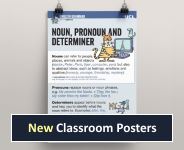Topic: Clause
These resources relate to clauses. Understanding how clauses work is useful for appreciating the different kinds of effects that writers achieve by using different structures, and also for developing writing skills.
- « first
- ‹ previous
- 1
- 2
- 3
Englicious contains many resources for English language in schools, but the vast majority of them require you to register and log in first. For more information, see What is Englicious?

